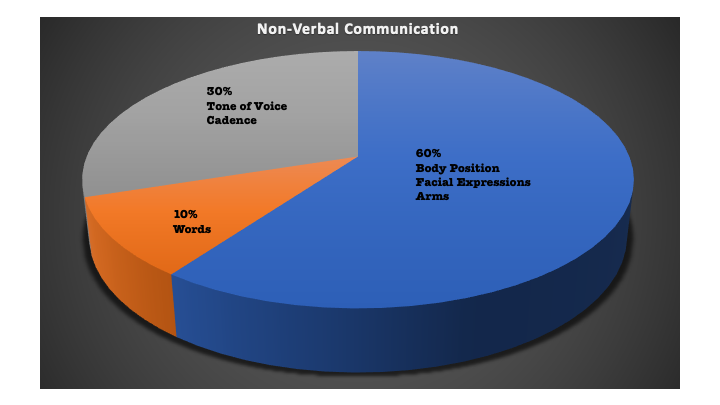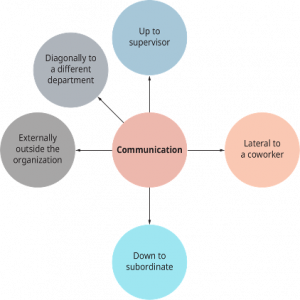8 Non-Verbal Mentoring Techniques
Chances are you have had many experiences where words were misunderstood, or where the meaning of words was unclear. When it comes to nonverbal communication, the meaning is even harder to discern. You can sometimes tell what people are communicating through their nonverbal communication, but there is no foolproof “dictionary” of how to interpret nonverbal messages.
Nonverbal Communication Is Fluid
Nonverbal communication is the process of conveying a message without the use of words. It can include gestures and facial expressions, tone of voice, timing, posture, and where you stand as you communicate. It can help or hinder a clear understanding of your message, but it doesn’t reveal (and can even mask) what you are really thinking. Nonverbal communication is far from simple, and its complexity makes your study and your understanding a worthy but challenging goal.
Nonverbal communication involves the entire body, the space it occupies and dominates, the time it interacts, and not only what is not said, but how it is not said. Confused? Try to focus on just one element of nonverbal communication and it will soon get lost among all the other stimuli. Consider one element, facial expressions. What do they mean without the extra context of chin position, or eyebrows to flag interest or signal a threat? Nonverbal action flows almost seamlessly from one movement to the next, making it a challenge to interpret one element or even a series of elements. How well can you correctly identify the feelings behind facial expressions?
Nonverbal communication is irreversible. In written communication, you can write a clarification, correction, or retraction. While it never makes the original statement go completely away, it does allow for correction. Unlike written communication, oral communication may allow “do-overs” on the spot: you can explain and restate, hoping to clarify your point. In your experience, you’ve likely said something you would give anything to take back, and you’ve learned the hard way that you can’t. Oral communication, like written communication, allows for some correction, but it still does not erase the original message or its impact. Nonverbal communication takes it one step further. You cannot separate one nonverbal action from the context of all the other verbal and nonverbal communication acts, and you cannot take it back.
Body Language
Nonverbal communication can be very ambiguous. We should not presume that we can ‘read other people’s minds’ because of what we think they are ‘saying’ nonverbally. We may be right, but equally, we may be wrong. To be clear, nonverbal communication contains more than just one component or aspect of conveying messages.
Communication should be regarded as a system. We cannot separate one part of the system from another and then, in isolation, interpret what is being communicated. To assist us in becoming more accurate in our decoding, we need to understand there are three sub-systems to communication. They are illustrated below

As illustrated, roughly ten percent of what we are communicating is actually in words. The other ninety percent is comprised of non-verbal tactics.
Head Movements
It may not be as simple as that, however, as we now know such nonverbal communication can often be culture-specific. While the positive head nod and negative headshake are commonly understood around the world, they are far from universal. In parts of Bulgaria and Greece, for example, nodding means no. In parts of the former Yugoslavia and southern India, shaking the head signifies yes.
In conversation, when people agree with the speaker, they tend to nod as the other speaks. If a person doesn’t nod, we may deduce that he or she disagrees with the speaker.
This type of non-verbal communication is often referred to as backchanneling and could be regarded as the feedback mechanism we discussed in the previous chapter. When we are listening effectively, we give nonverbal feedback by nodding, smiling, and even respond with sounds. (e.g. ‘Uh-huh’)
Oftentimes individuals in conversation who wish to take over the conversation may increase their rate of head-nods, lean forward in their seats, or gesture for attention with their hand.
Signals
Communication is a social process, as it takes at least two people to engage in communication. There is a variety of social influences that can affect the accuracy of the intended message. For example, status barriers between apprentices at different levels of the organization can have an influence om how one communicates. Also issues such as addressing your boss as “Mr. Jamieson” or your journeyperson as “Mike” can vary depending on context and circumstance. Prevailing norms and roles can dictate who speaks to whom and how someone responds. As what may happen when a monthly meeting occurs where different stakeholders meet to discuss reasons for why a project has fallen behind schedule. Diagram 1 illustrates a variety of communications that illustrate social influences in the workplace.

In addition, the communication process is heavily influenced by perceptual processes. Meaning, the process of communication can be heavily influenced by what a person thinks, believes, or feels. The extent to which an employee accurately receives and decodes job instructions from a supervisor may be influenced by her perception of the supervisor, especially if the job instructions conflict with her interest in the job or if they are controversial. If an apprentice has stereotyped the journeyperson as incompetent, chances are that little that what the journeyperson says will be taken seriously. If the boss is well regarded or seen as influential in the company or the industry, everything that she says may be interpreted as important.
Gestures
Gestures involve using your arms and hands while communicating. Gestures provide a way to channel your nervous energy into a positive activity that benefits your speech and gives you something to do with your hands. For example, watch people in normal, everyday conversations. They frequently use their hands to express themselves. Do you think they think about how they use their hands? Most people do not. Their arm and hand gestures come naturally as part of their expression, often reflecting what they have learned within their community.
For senior apprentices and journeypeople, this is also true, and deliberate movement can reinforce, repeat, and even regulate an apprentice’s response to their verbal and nonverbal messages. If you want to help your communication come across as comfortable and natural, the way in which you use of your arms and hands contributes to your message, both in coding and decoding. We can easily recognize that a well-chosen gesture can help make the point understandable and lead the apprentice to the main point of what is being communicated.
Facial Gestures
Facial gestures should reflect the tone and emotion of your verbal communication. Displaying no emotion through your facial gestures can lead to a miscommunication or worse, a misunderstanding in the decoding process. Often it is best to be yourself when communicating your message, however, one needs to understand how their facial gestures communicate their decoding process. This kind of gesture is what the speaker looks for in the feedback mechanisms of communication and can become an integral part of helping each person convey they have understood the message.
Eye contact refers to the speaker’s gaze that deliberately engages those in the conversation. It can vary in degree and length, and in many cases, is culturally influenced. Both in the speaker’s expectations and the receiver’s notion of what is appropriate will influence normal expectations for eye contact. Depending on the culture, eye contact (or the lack thereof) may be nonverbal signals of active listening.
Key Takeaways

